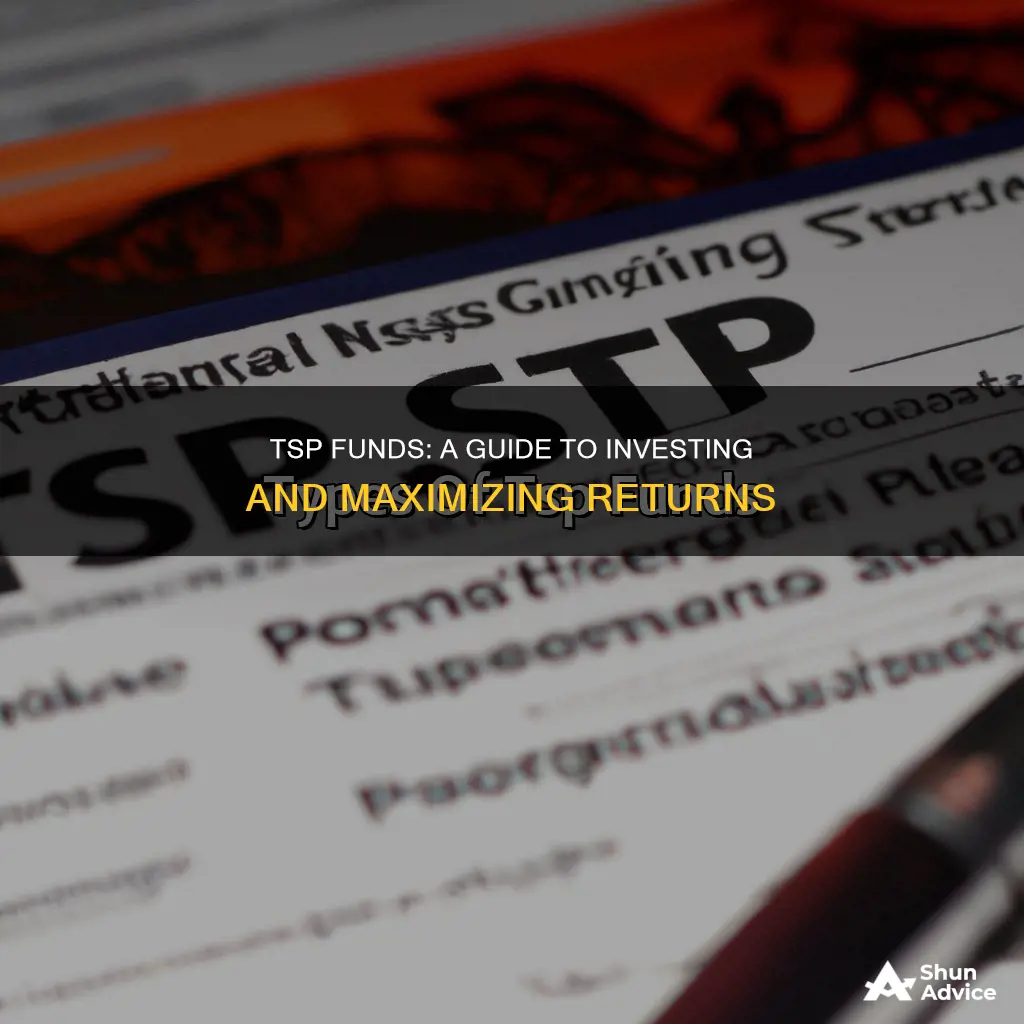
The Thrift Savings Plan (TSP) is a retirement savings and investment plan for federal employees and military personnel in the US. Similar to a 401(k) plan, TSP contributions can be taken directly from an employee's paycheck and invested in a variety of different funds. There are five core TSP funds available, four of which are diversified index funds. Each index fund specialises in a different asset class or market segment, such as US equities, international equities, and corporate bonds. The fifth core fund, the G Fund, invests in very low-risk, low-yield government bonds.
| Characteristics | Values |
|---|---|
| What is TSP? | A retirement savings and investment plan for federal employees and members of the military. |
| Who is eligible for TSP? | Federal government employees and members of the military. |
| TSP contribution limit for 2024 | $23,000. If you're 50 or older, you can contribute an additional $7,500 as a catch-up contribution. |
| TSP contribution limit for 2022 | $20,500. If you're 50 or older, you can contribute an additional $6,500 as a catch-up contribution. |
| TSP contribution limit for 2021 | $19,500. If you're 50 or older, you can contribute an additional $6,500 as a catch-up contribution. |
| Types of TSP funds | Lifecycle Funds (L Funds) and Individual TSP funds (G, F, C, S, and I Funds) |
| Number of L Funds | 11 |
| G Fund | Invested in short-term U.S. Treasury securities. |
| F Fund | Invested in a bond index fund that tracks the Bloomberg Barclays U.S. Aggregate Bond Index. |
| C Fund | Invested in a stock index fund that tracks the Standard & Poor's 500 (S&P 500) Index. |
| S Fund | Invested in a stock index fund that tracks the Dow Jones U.S. Completion Total Stock Market (TSM) Index. |
| I Fund | Invested in a stock index fund that tracks the MCSI EAFE (Europe, Australasia, Far East) Index. |
What You'll Learn

Understanding the Thrift Savings Plan (TSP)
The Thrift Savings Plan (TSP) is a defined-contribution retirement savings and investment plan for federal employees and uniformed service members, including the Ready Reserve. It offers similar tax benefits and savings to those of a 401(k) plan in the private sector.
The TSP is designed to help participants save for retirement. It offers immediate tax breaks on savings, and the option to invest in a Roth for tax-free withdrawals in retirement. The TSP also allows participants to benefit from agency matching contributions.
There are several ways to invest in a TSP, including automatic payroll contributions, tax-deferred contributions, and after-tax investments. The contribution limit for 2024 is $23,000, with employees aged 50 and over able to contribute an additional $7,500.
The TSP offers a choice of six funds and a mutual fund option:
- Government Securities Investment (G) Fund
- Fixed-Income Index Investment (F) Fund
- Common-Stock Index Investment (C) Fund
- Small-Capitalization Stock Index Investment (S) Fund
- International-Stock Index Investment (I) Fund
- Lifecycle (L) Funds
The Lifecycle (L) Funds are a mix of the five individual TSP funds, designed to provide an appropriate level of risk for the participant based on their age and how soon they will need access to their money.
The TSP is a secure way for federal employees and service members to save for retirement, offering a range of investment options to suit different needs and goals.
A Monthly Guide to Index Fund Investing
You may want to see also

TSP investment options
The Thrift Savings Plan (TSP) is a retirement savings and investment plan for federal employees and military personnel in the US. It is similar to a 401(k) plan, with tax benefits and payroll contributions.
There are three approaches to investing your TSP savings:
Lifecycle Funds (L Funds)
Each of the eleven L Funds is a diversified mix of the five individual TSP funds. They are designed to let you invest your entire portfolio in a single L Fund, with the best expected return for the amount of risk that is appropriate for you, based on when you will need your money. L Funds are ideal for those who don't want to make their own asset allocations. They are considered "automatic pilot" funds, which shift from high-risk to low-risk options as the target date approaches.
Individual TSP Funds
You can choose your own mix of investments from the five individual TSP investment funds (G, F, C, S, and I Funds). These funds include a short-term U.S. Treasury security and index funds made of stocks and bonds.
- Government Securities Investment (G) Fund: Invested in short-term U.S. Treasury securities, this fund offers the opportunity to earn rates of interest similar to long-term government securities with no risk of loss of principal. It is considered the safest investment choice in the plan.
- Fixed Income Index Investment (F) Fund: This fund invests in a wide range of debt instruments, including publicly traded treasury and government agency securities, corporate and non-corporate bonds, and asset-backed securities (ABS). It offers the potential for higher returns than the G Fund, but there is no guarantee of the return of the investor's principal.
- Common Stock Index Investment (C) Fund: The C Fund is the most conservative of the three stock funds available in the TSP. It invests in 500 large and mid-cap companies that comprise the Standard and Poor's 500 Index. It has experienced greater volatility than the G or F Funds but has posted higher returns over time.
- Small-Capitalization Stock Index Investment (S) Fund: The S Fund includes stocks from small- to mid-sized companies that offer high risk and high returns. It has greater volatility than the C Fund and is considered one of the two funds with the greatest risk in the TSP.
- International Stock Index Investment (I) Fund: This fund invests in stocks from overseas companies in 21-22 developed countries. It is regarded as the other high-risk fund in the TSP and has historically posted higher average annual returns than the C Fund.
Mutual Fund Window
If you meet certain eligibility requirements and pay the necessary fees, you can choose to invest a portion of your TSP savings in your choice of available mutual funds through the mutual fund window. This option requires an initial investment of at least $10,000, and you cannot invest more than 25% of your total account in the mutual fund window or set up automatic contributions.
Gilt Funds: When to Invest for Maximum Returns
You may want to see also

TSP contribution limits
The Thrift Savings Plan (TSP) is a retirement investment program offered to US government employees. It is similar to the 401(k) plans offered by private-sector employers.
The Internal Revenue Service (IRS) has set the TSP elective deferral limit for 2024 at $23,000 per year. This is the maximum amount that employees can elect to contribute each year to their TSP accounts. It is important to note that this limit does not include any matching contributions from employers. Employees who are covered by the Federal Employees Retirement System (FERS) and reach the annual limit before the end of the calendar year will lose valuable Agency Matching TSP contributions. To maximise their contributions for 2024, FERS employees should limit their bi-weekly contributions to $884.61 ($23,000/26 pay periods = $884.61).
In addition to regular TSP contributions, employees who are 50 or older (or will turn 50 in 2024) can also make catch-up contributions. The 2024 IRS annual limit for catch-up contributions is $7,500. This amount is in addition to the regular TSP limit, allowing employees to contribute up to a total of $30,500 in 2024. To maximise both the regular and catch-up contributions, employees would need to contribute $1,173.07 per pay period ($30,500/26 pay periods = $1,173.07).
It is worth noting that the annual additions limit is the total amount of all contributions made in a calendar year, including employee contributions, Agency/Service Automatic (1%) Contributions, and Agency/Service Matching Contributions. This limit is per employer and does not include catch-up contributions.
Bond Funds: Best Time to Invest and Why
You may want to see also

Choosing the best TSP funds
The Thrift Savings Plan (TSP) is a retirement investment program offered to US government employees. It is similar to a 401(k) plan, offering five core mutual funds to invest in, four of which are diversified index funds. Each of these funds specializes in a different asset class or market segment, such as US equities, international equities, and corporate bonds.
The five core funds are:
- Government Securities Investment Fund (G Fund)
- Fixed-Income Investment Index Fund (F Fund)
- Common Stock Index Investment Fund (C Fund)
- Small-Capitalization Stock Index Fund (S Fund)
- International Stock Index Investment Fund (I Fund)
The G Fund is the only fund that does not invest in an index. It invests in a special non-marketable treasury security issued by the US government and is the only fund that guarantees the return of the investor's principal. It is intended for very conservative investors and has the lowest risk and lowest rate of return of the five funds.
The F Fund is the next step up in terms of risk and reward. It invests in a range of debt instruments, including treasury and government agency securities, corporate and non-corporate bonds, and asset-backed securities. This fund pays monthly interest, typically higher than the G Fund, but does not guarantee the return of the principal.
The C Fund is the most conservative of the three stock funds, investing in the 500 large and mid-cap companies that make up the Standard and Poor's 500 Index. It has experienced greater volatility than the G or F Funds but has posted higher returns over time.
The S Fund holds securities of over 4,000 smaller, less established companies with greater potential for growth than those in the C Fund. It is one of the two funds with the greatest risk in the TSP and has outperformed the C Fund with greater volatility.
The I Fund is the other high-risk fund, investing in larger, more established companies in 21 developed countries outside the US. It has historically posted a higher average annual return than the C Fund.
In addition to the five core funds, there are Lifecycle (L) Funds, which are composite funds that invest in a combination of the five core funds. These funds are designed to let you invest your entire portfolio in a single L Fund and get the best expected return for the amount of risk that is appropriate for you, based on your age and when you'll need your money.
When choosing the best TSP funds, it's important to consider your risk tolerance, investment time horizon, and personal comfort with volatility and potential swings in valuation. Investing for retirement is a long-term strategy, and it's generally recommended to take a hands-off approach, checking on your investments once or twice a year.
Bond Mutual Funds: When to Invest for Maximum Returns
You may want to see also

TSP vs. 401(k) plans
The Thrift Savings Plan (TSP) and 401(k) are two of the most popular retirement savings plans. While both plans are designed to help you save for retirement, there are some key differences to note when deciding which one is right for you.
Contribution Limits
The TSP has a lower contribution limit than the 401(k) but allows for catch-up contributions for those over age 50. The 401(k) has a higher contribution limit but does not allow for catch-up contributions. For 2024, employees can contribute up to $23,000 to either a 401(k) or a TSP. If you are age 50 or older, you can use the catch-up provision to contribute an additional $7,500.
Investment Options
The TSP offers a limited number of investment options, while the 401(k) offers a wider range. The TSP offers five main investment options: government securities, fixed income, common stocks, small-cap stocks, and international stocks. The 401(k) may offer a mix of mutual funds, exchange-traded funds (ETFs), and individual stocks.
Fees and Expenses
The TSP has some of the lowest fees and expenses of any retirement plan, while the 401(k) can have higher fees and expenses. The TSP has an annual expense ratio of just 0.042%, while the average expense ratio for 401(k) plans is around 1%.
Withdrawal Rules and Penalties
Both plans allow penalty-free withdrawals starting at age 59 1/2. Early withdrawals typically incur a 10% penalty, in addition to taxes on traditional withdrawals. However, there are some exceptions to this penalty, such as for certain medical expenses or if you become disabled.
Employer Contributions and Matching
TSP plans offer automatic employer contributions of 1% of your salary, regardless of whether you contribute to the plan or not. TSP plans also offer matching contributions for the first 5% of your salary that you contribute. 401(k) plans may or may not offer automatic employer contributions, and the amount may be lower than that of a TSP plan. However, many 401(k) plans offer more generous matching contributions.
Portability and Transferability
A TSP account may offer more in terms of portability and transferability than a 401(k) account. If you leave your job, you can keep your TSP account open and continue to manage your investments through the plan. With a 401(k) account, you may need to roll over your account to a new employer's plan or to an individual retirement account (IRA) to avoid penalties and fees.
Unlocking Private Credit Funds: A Guide to Smart Investing
You may want to see also
Frequently asked questions
The Thrift Savings Plan is a retirement savings and investment plan for federal employees and members of the military. It is similar to a 401(k) plan, with tax benefits and the option to have contributions taken directly from your paycheck.
Enrolling in the TSP is automatic if you joined the federal service on or after 1 October 2020. You can also enrol online via your agency's electronic payroll system or by paper form.
You can change your TSP fund allocation via the Thrift Savings Plan website. There are two ways to do this: a contribution-allocation adjustment, which changes how new money is invested, and an interfund transfer (IFT), which shifts your existing funds from one investment to another. You are only allowed two IFTs per calendar month.







